|
|
|
Sort Order |
|
|
|
Items / Page
|
|
|
|
|
|
|
| Srl | Item |
| 1 |
ID:
108345
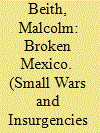

|
|
|
|
|
| Publication |
2011.
|
| Summary/Abstract |
The Mexican drug war, in full swing since December 2006, has now claimed more than 40,000 lives. Dozens of high-level cartel operatives have been captured or killed, yet the leadership of one cartel, from Sinaloa in northwestern Mexico, has remained apparently untouched. The apparent lack of a crackdown on the Sinaloa Cartel has spurred criticisms of the Calderón administration, as well as US authorities aiding in the drug fight - some critics contend that the Sinaloa Cartel has enjoyed protection from the authorities. The Sinaloa Cartel's history of protection and collusion by authorities goes back a long way - during the reign of the PRI from 1929 to 2000, Sinaloa's drug traffickers were allowed to operate with near-total impunity. But mounting evidence - captures and deaths of high-level operatives from Sinaloa as well as arrests of relatives of the leadership - suggests that the claims of collusion against the current Mexican administration are false.
|
|
|
|
|
|
|
|
|
|
|
|
|
|
|
|
| 2 |
ID:
108349
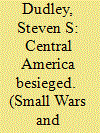

|
|
|
|
|
| Publication |
2011.
|
| Summary/Abstract |
The following is a threat assessment of the seven countries that make up Central America. That region is struggling to control burgeoning street gangs and organized criminal groups which have overrun its poor and ill-prepared security forces. The results are clear: rising crime and homicide rates throughout the region; corruption and instability within the governments. The two gangs that challenge authority are transnational in nature but pose less a threat to national security than they do to everyday life. Their drug peddling and extortion have shattered entire communities and forced the governments to reallocate important resources. The governments' strategy of jailing suspected gang members en masse has arguably made them stronger rather than weaker. Meanwhile, the organized criminal groups have deeply penetrated governments at nearly every level. They control swaths of territory, co-opting these areas, as well as the local governments, for their own purposes. Opposition to them is often futile. Mexican-based organizations are increasingly using violent tactics to displace their rivals. The governments of the region seem unprepared to meet the challenge.
|
|
|
|
|
|
|
|
|
|
|
|
|
|
|
|
| 3 |
ID:
108342
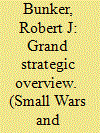

|
|
|
|
|
| Publication |
2011.
|
| Summary/Abstract |
This grand strategic overview highlights and analyzes the influence of epochal change on the state and conflict and the new realities with which the United States must now contend. This deep context is being provided so that (1) the belligerent and politicized non-state entities that have emerged in Mexico and the Americas can be better understood within the larger three-front grand strategic temporal conflict the US is now engaged in; and (2) the stark realities that the US faces - such as loss of unilateral world dominance, increasing debt and ongoing deficits, shifting demographics, inability to staunch the flow of and demand for illicit drugs, and an increasing prison population - are highlighted. Finally, this essay finishes with a discussion of the many important contributions contained in this edited work.
|
|
|
|
|
|
|
|
|
|
|
|
|
|
|
|
| 4 |
ID:
108344
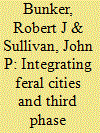

|
|
|
|
|
| Publication |
2011.
|
| Summary/Abstract |
This essay addresses and integrates 'feral cities' with 'third phase cartel' and 'third generation gangs' (3GEN Gangs) research. The feral cities diagnostic tool will be expanded from three levels (green, yellow, and red) to five (adding purple and black). This will be accomplished by means of the addition of two new levels that model the shift from ferality (de-institutionalization) to criminal re-institutionalization of urban social and political structures around new patterns of living. Such processes set the stage for the projected emergence of the BlackFor (Black Force) within the Americas. BlackFor represents a confederation of illicit non-state actors - essentially a postmodern form of societal cancer - linked together by means of a network of criminalized and criminal (narco) cities as are now arising.
|
|
|
|
|
|
|
|
|
|
|
|
|
|
|
|
| 5 |
ID:
108346
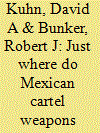

|
|
|
|
|
| Publication |
2011.
|
| Summary/Abstract |
This essay will provide an overview of the major policy positions articulated in the literature pertaining to Mexican cartel weapons origins. The four major positions related to firearms are those of the US Bureau of Alcohol, Tobacco, Firearms and Explosives (BATF), the Mexican government under the Felipe Calderón administration, US interest groups focusing on firearms regulation, and US interest groups focusing on firearms deregulation. The essay will then analyze the major sources of Mexican cartel weapons and then provide conclusions stemming from this analysis and the future trends identified. A component of this assessment will be the provision of gross estimates of the weapons sources themselves in order to show that Mexican cartel weapons origins are diverse in nature and have been increasing in sophistication over time from basic civilian arms into paramilitary and military arms. Part of the reason for this increase in sophistication has been the rise of Los Zetas which has resulted in a deadly 'arms race' taking place between the various Mexican cartels.
|
|
|
|
|
|
|
|
|
|
|
|
|
|
|
|
| 6 |
ID:
108343
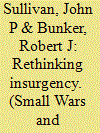

|
|
|
|
|
| Publication |
2011.
|
| Summary/Abstract |
Driven by globalization, Internet communications technology (ICT), and new economic forms the nature of states may be changing. Transnational criminal organizations (TCOs) - including what are commonly known as cartels - are early adopters to the new political/economic landscape. In addition to seeking to rule the illicit economy, criminal actors (networked cartels and gangs) are challenging states through high-order violence and leveraging nascent social/spiritual movements (narcocultura) to potentially usher in a new political dynamic. These violent non-state actors (criminal soldiers) are insurgent actors. They are waging new forms of insurgency - criminal and possibly spiritual - that have the potential to reconfigure states.
|
|
|
|
|
|
|
|
|
|
|
|
|
|
|
|
| 7 |
ID:
108348


|
|
|
|
|
| Publication |
2011.
|
| Summary/Abstract |
There are numerous small, irregular, asymmetric, and revolutionary wars ongoing around the world today. In these conflicts, there is much to be learned by anyone who has the responsibility of dealing with, analyzing, or reporting on national security threats generated by state and non-state actors. The cases we examine (Mexico, Jamaica, Colombia, Argentina, and Peru) demonstrate how the weakening of national stability, security, and sovereignty can indirectly and directly contribute to personal and collective insecurity, radical political change, and possible state failure. These cases are also significant beyond their uniqueness. The common political objective in each diverse case isone way or anotherto control governments, and/or coerce radical change in discrete political-social-economic systems. This defines war as well as insurgency, and shifts the asymmetric global security challenge from abstract to real.
|
|
|
|
|
|
|
|
|
|
|
|
|
|
|
|
| 8 |
ID:
108347
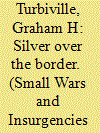

|
|
|
|
|
| Publication |
2011.
|
| Summary/Abstract |
US national security is seriously challenged by the more visible appearance of American law enforcement and security corruption among organizations charged with policing and protecting the US-Mexican border. A burgeoning number of allegations, criminal investigations, indictments, and convictions directed against US law enforcement personnel calls into question the fundamental integrity of US border security forces and leadership, as well as the willingness or capability of key agencies and their executive branch leadership to effect reforms. For the United States, such law enforcement and other official US Government corruption acts like corrosive acid on the legitimacy of these institutions and upon domestic and allied trust in their integrity and competence.
|
|
|
|
|
|
|
|
|
|
|
|
|
|
|
|
|
|
|
|
|